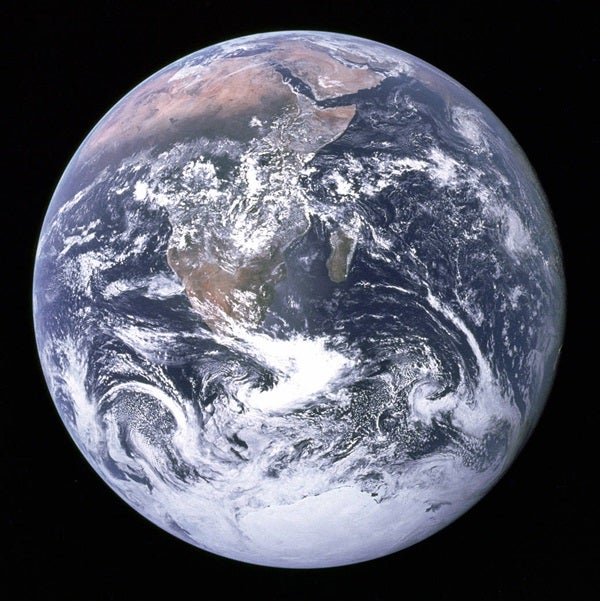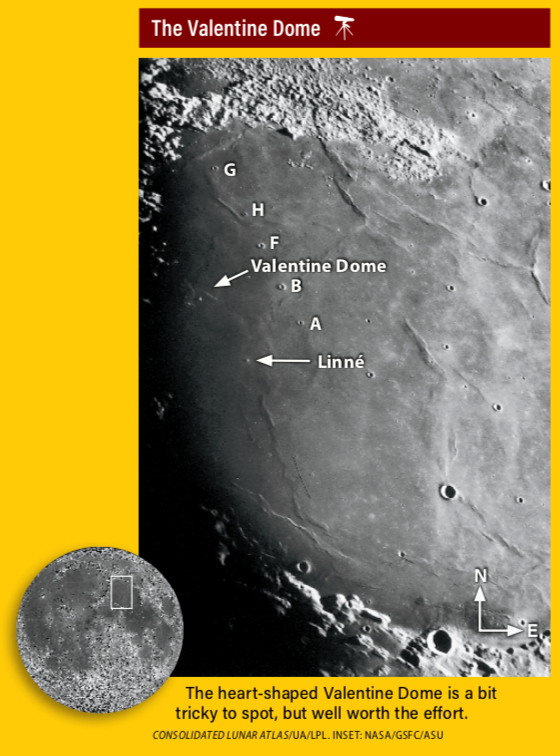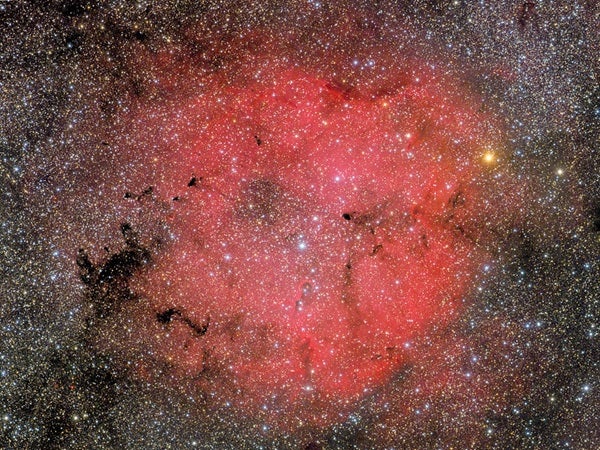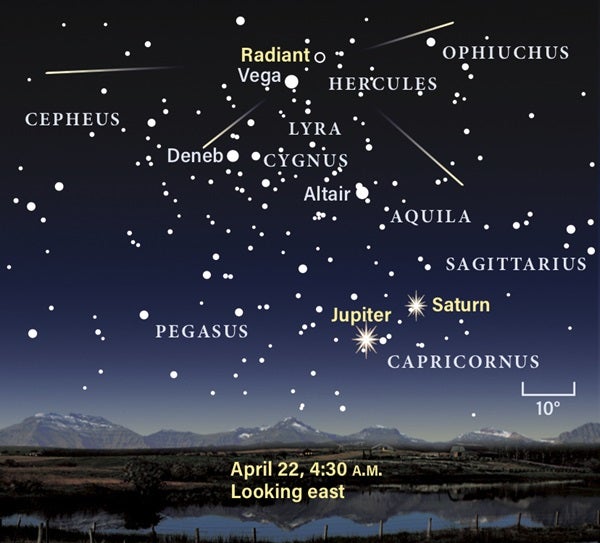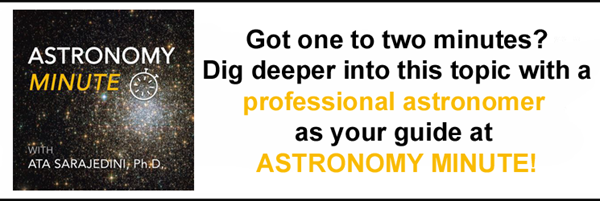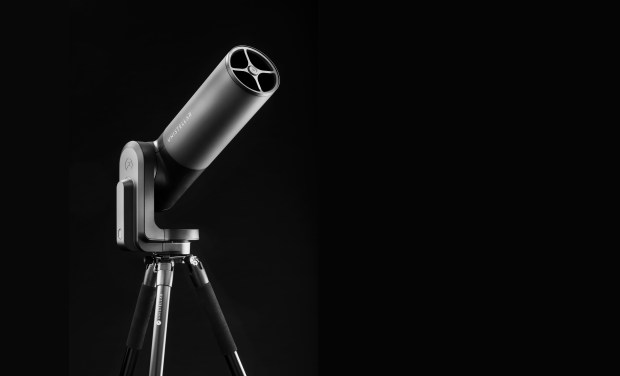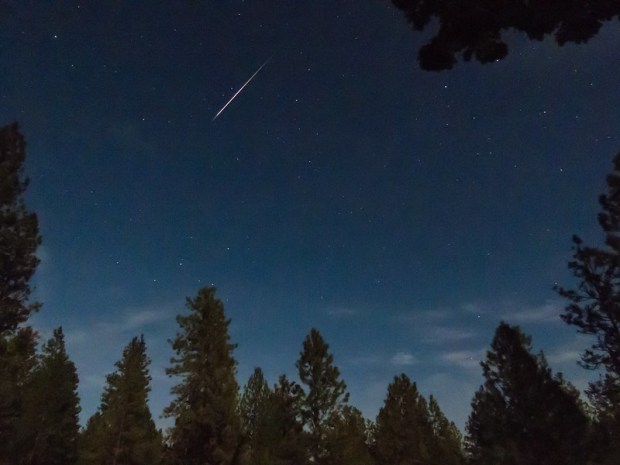Friday, April 16
Tonight after sunset, look west to spot Taurus the Bull slowly sinking toward the horizon. Mars and the Moon straddle the space between the Bull’s two horns, marked by the stars Alheka (left) and Elnath (right). The Moon sits 5.6° west of the Red Planet, which lies above the horns and glows a faint magnitude 1.4. Mars also spans a tiny 5″, as it now sits roughly 1.9 astronomical units from Earth. (One astronomical unit, or AU, is the average Earth-Sun distance.)
Compare Mars with ruddy Aldebaran, glowing more brightly — magnitude 0.9 — about 18° west-southwest of the planet (appearing almost directly below it in the sky). Of course, Mars’ color comes from sunlight reflecting off its oxidized (rusty) surface, while Aldebaran is a red giant star, whose color comes from the relatively cool temperature of its atmosphere.
Over the next 24 hours, the Moon will approach Mars, passing less than a degree to the planet’s south. Tomorrow night, you can find Mars in the same place, but the Moon will have switched sides, sitting roughly the same distance east of the planet, instead.
Sunrise: 6:20 A.M.
Sunset: 7:40 P.M.
Moonrise: 8:54 A.M.
Moonset: —
Moon Phase: Waxing crescent (18%)
*Times for sunrise, sunset, moonrise, and moonset are given in local time from 40° N 90° W. The Moon’s illumination is given at 12 P.M. local time from the same location.
Saturday, April 17
The Moon passes 0.1° south of Mars at 8 A.M. EDT. Although the pair is not above the horizon at that time, look west again after sunset to see how their relative positions have changed since yesterday evening.
Instead of focusing on Mars tonight, instead key in on the Moon. Tonight’s target is the Valentine Dome — a gently sloping heartshaped dome rising less than 400 feet (122 meters) above the lunar surface. It’s only visible at low Sun angles, such as today. By tomorrow, it will be all but invisible as the angle of the sunlight changes.
Look for the Valentine Dome along the western flank of the Sea of Serenity. Nearby (to the east) is a line of craters: Linné A, B, F, H, and G. If you aren’t able to find it tonight, don’t worry — the tableau will repeat itself when the Sun shines at a low angle (this time, from the west) early next month, on May 2.
Sunrise: 6:19 A.M.
Sunset: 7:41 P.M.
Moonrise: 9:35 A.M.
Moonset: 12:15 A.M.
Moon Phase: Waxing crescent (26%)
Sunday, April 18
Brilliant Jupiter has a special surprise in store for early-morning risers today. The bright (magnitude –2.1) planet lies in northeastern Capricornus, with dimmer (magnitude 0.6) Saturn nearly 14° to its upper right (west). But the real spectacle is Jupiter’s moons — grab a telescope and center it on the giant planet by about 5:50 A.M. EDT (note that this may be a bit challenging for East Coast observers, but those farther west will still have dark skies).
Look on the western side of Jupiter, where, from closest to farthest, sit Io, Europa, and Ganymede. Callisto appears alone on the planet’s eastern side. At 5:52 A.M. EDT, Io’s shadow will begin to eclipse Europa, despite the fact that the two “appear” relatively far apart (44″). The event progresses quickly, ending just five minutes later at 5:57 A.M. EDT, but during those five minutes, roughly 87 percent of Europa will be covered by the smaller moon’s shadow. This type of event, where two of Jupiter’s moons eclipse or occult each other, is called a mutual event. Every six years, the plane of Jupiter’s Galilean satellites aligns with our line of sight from Earth, allowing us to really probe the effects orbital dynamics in this stunning system. Several such events will be visible throughout the year, so stay tuned for more.
Mercury is in superior conjunction at 10 P.M. EDT. Later this month, it will appear in the evening sky alongside Venus.
Sunrise: 6:17 A.M.
Sunset: 7:42 P.M.
Moonrise: 10:22 A.M.
Moonset: 1:11 A.M.
Moon Phase: Waxing crescent (35%)
Monday, April 19
Roughly 21° above the southwestern horizon at sunset is the brightest star in the northern sky: Sirius, or Alpha (α) Canis Majoris. This easy-to-spot star appears left (southeast) of the famous three stars that make up Orion’s Belt.
But let’s stick to Canis Major, Orion’s Big Dog. 145 Canis Majoris is a beautiful pair of stars with stunning contrasting colors. It is sometimes called the Winter Albireo or the Southern Albireo, as it appears much like the double star — you guessed it — Albireo in Cygnus the Swan.
The pair is located a little less than 10° southeast of Sirius, or 3.5° northeast of Wezen (magnitude 1.8 Delta [δ] Canis Majoris). An hour after sunset tonight, magnitude 4.8 145 Cma appears directly above Wezen. Although it shines a single star to the naked eye, large binoculars (16×70) or a small telescope should split the pair into a brighter gold and dimmer blue star.
Sunrise: 6:16 A.M.
Sunset: 7:43 P.M.
Moonrise: 11:18 A.M.
Moonset: 2:02 A.M.
Moon Phase: Waxing crescent (44%)
Tuesday, April 20
First Quarter Moon occurs this morning at 2:59 A.M. EDT.
Asteroid 4 Vesta sits a mere 35′ from magnitude 5.5 51 Leonis tonight. The asteroid, which glows an easy magnitude 6.6, can be picked up with binoculars even from a relatively light-polluted city. 51 Leo is located roughly halfway along and slightly below a line drawn from magnitude 2.6 Zosma to magnitude 2 Algieba in the Lion. Glance slightly southeast of 51 Leo to find Vesta.
Tonight is the last good night for a few days to observe this particular asteroid. The Moon’s bright light will interfere with your asteroid viewing until the 24th. Vesta will reach its stationary point two days from now, after which it will halt its northwestern motion to make a tight turn and swing back around, moving southeast with respect to the background stars of Leo.
Discovered in the early 19th century by Wilhelm Olbers, Vesta spans about 310 miles (500 kilometers) and is the second-largest body in the main asteroid belt after 1 Ceres.
Sunrise: 6:14 A.M.
Sunset: 7:44 P.M.
Moonrise: 12:19 P.M.
Moonset: 2:47 A.M.
Moon Phase: Waxing gibbous (54%)
Wednesday, April 21
With a bright moon in Leo tonight, let’s concentrate our gaze on the other side of the sky, where it’s slightly darker. The constellation Cepheus the King is home to Herschel’s Garnet Star, so named for its deep ruby red color. Cataloged as Erakis or Mu (μ) Cephei, this 4th-magnitude star is one of the largest and brightest red supergiant stars in the Milky Way. It shines with some 300,000 to 400,000 times the brightness of our Sun and is so large that if you placed Mu Cephei in the middle of our own solar system, it would stretch all the way to a point between the orbits of Jupiter and Saturn. Mu also a variable star whose brightness changes by almost a full magnitude over the course of about 2–2.5 years.
The easiest way to find Mu is by drawing a line between Alderamin and Zeta (ζ) Cephei, which form the base of the house-shaped constellation. Mu is about halfway along this line and roughly 1.5° below it. Just over 1° further below (south of) Mu is the open cluster IC 1396, a faint scattering of about 50 stars that pops out best in high-power binoculars or a telescope. The cluster is embedded within a large emission nebula that isn’t easily visible without the use of narrowband nebula filters, but which stands out beautifully in astrophotos.
Sunrise: 6:13 A.M.
Sunset: 7:45 P.M.
Moonrise: 1:26 P.M.
Moonset: 3:28 A.M.
Moon Phase: Waxing gibbous (65%)
Thursday, April 22
The springtime Lyrid meteor shower peaks this morning, although the bright Moon will hinder your viewing until shortly before sunrise. Once the 10-day-old Moon sets around 4 A.M., though, it’s prime meteor-hunting time! At that time, the Lyrids’ radiant will be relatively high (nearly 80°) in the east, to the upper right of the bright star Vega. The shower is expected to produce about 18 meteors per hour at its maximum; Northern Hemisphere observers can expect a slightly attenuated amount, but some bright streaks may still appear, making an early-morning observing session highly worthwhile. The Lyrids will last until the end of the month, so you might continue to see more shooting stars than average as the shower winds down over the next week.
There’s even a bonus: Jupiter and Saturn floating nearby in Capricornus. The two planets make excellent targets in binoculars or a telescope, so you can switch off between scanning the skies with your naked eyes for meteors and spending a few moments to enjoy the giant planets as they rise ahead of the Sun.
Asteroid Vesta is stationary at 2 P.M. EDT today.
Since 1970, the world has recognized April 22 as Earth Day — a celebration of our unique home in the solar system. Earth Day also brings into the spotlight the fragility of our planet and serves as a call to action to ensure we take steps to protect it from the aspects of human-driven change that are harmful. You can find out more about this special celebration on earthday.org, and keep an eye on Astronomy.com for additional content highlighting our planet Earth.
Sunrise: 6:11 A.M.
Sunset: 7:46 P.M.
Moonrise: 2:34 P.M.
Moonset: 4:03 A.M.
Moon Phase: Waxing gibbous (75%)
Friday, April 23
Early morning observers have the chance to catch a famous asterism, or unofficial grouping of stars. An hour or two before sunrise, look for Vulpecula the Fox in the eastern sky, just south (right) of the more famous Cygnus the Swan.
Hidden within Vulpecula is Brocchi’s Cluster, also known as the Coathanger. To find it, first locate bright Albireo (Beta [β] Cygni), the Swan’s head. Draw an imaginary line 3.3° south and you’ll hit 4th-magnitude Anser (Alpha Vulpeculae). Continue that line about 4.5° in the same direction and you’ll alight on the Coathanger, which looks just like the everyday object from which it gains its name. Six stars form the line at the bottom of the hanger, while four stars create the curved hook. Wide-field binoculars (7x to 10x) will give you the best views, as it covers nearly 1.5° lengthwise and 0.5° in height (from the base to the top of the hook’s curve).
As a bonus, the relatively faint (magnitude 8.8) open cluster NGC 6802 lies just east of the Coathanger asterism. Larger binoculars or a small scope should net you this irregular scattering of stars.
If this particular grouping of stars didn’t feel challenging enough, don’t worry — there’s also a smaller, fainter Mini Coathanger in Ursa Minor that we’ll visit in the near future!
Sunrise: 6:10 A.M.
Sunset: 7:47 P.M.
Moonrise: 3:46 P.M.
Moonset: 4:34 A.M.
Moon Phase: Waxing gibbous (84%)

